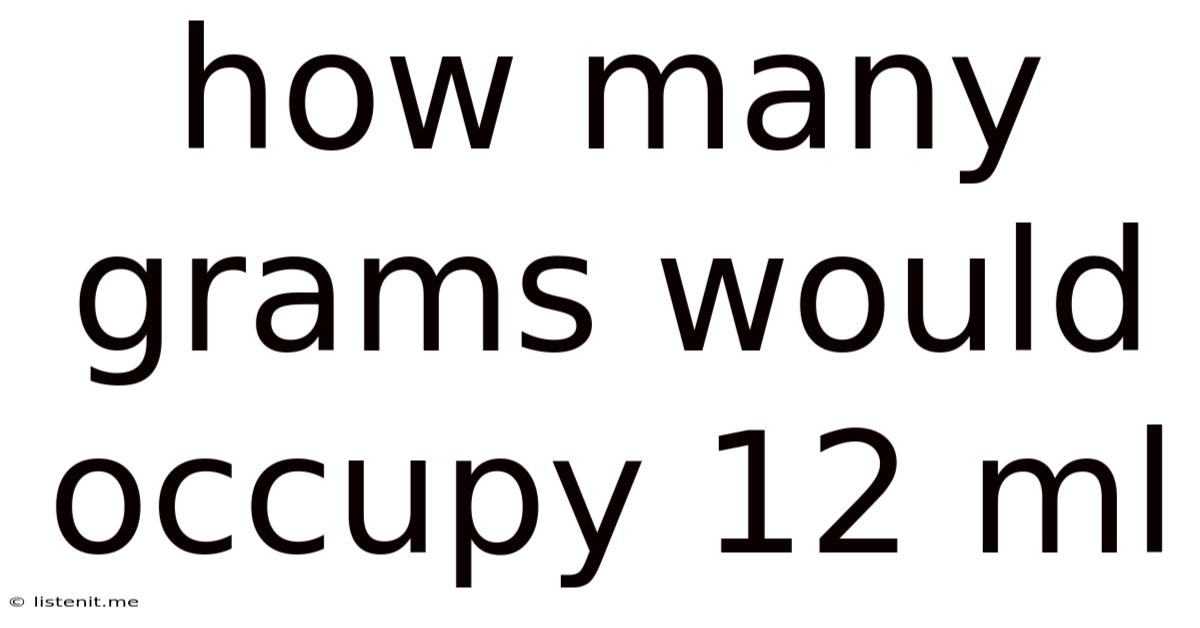How Many Grams Would Occupy 12 Ml
listenit
May 12, 2025 · 4 min read

Table of Contents
How Many Grams Would Occupy 12 ml? Understanding Density and Volume
Determining how many grams occupy 12 ml requires understanding a fundamental concept in science: density. Density is the mass of a substance per unit volume. It's essentially how tightly packed the matter is within a given space. The formula for density is:
Density = Mass / Volume
This means that to find the mass (in grams) that occupies 12 ml, we need to know the density of the substance. Since different substances have different densities, there's no single answer to this question. A cubic centimeter (cm³) is equivalent to a milliliter (ml), so we can use these units interchangeably in our calculations.
The Crucial Role of Density
Density is expressed in various units, commonly grams per cubic centimeter (g/cm³) or grams per milliliter (g/ml). Water, under standard conditions, has a density of approximately 1 g/ml. This means 1 ml of water has a mass of 1 gram. However, substances like gold are much denser, meaning a small volume of gold will have a significantly higher mass than the same volume of water. Conversely, substances like air have very low densities.
Let's explore this further with examples:
Example 1: Water
If we're dealing with water, and its density is approximately 1 g/ml, then 12 ml of water would have a mass of:
Mass = Density × Volume = 1 g/ml × 12 ml = 12 grams
So, 12 ml of water would occupy 12 grams.
Example 2: Gold
Gold, on the other hand, is significantly denser than water. Its density is approximately 19.3 g/ml. Therefore, 12 ml of gold would have a mass of:
Mass = Density × Volume = 19.3 g/ml × 12 ml = 231.6 grams
This illustrates how drastically the mass can change depending on the substance's density.
Example 3: Air
Air has a much lower density, varying depending on temperature and pressure. At standard temperature and pressure (STP), the density of air is approximately 1.225 kg/m³. To use this with our 12 ml volume, we need to convert units:
- 1 m³ = 1,000,000 ml
- Density of air in g/ml = 1.225 kg/m³ × (1000 g/kg) × (1 m³/1,000,000 ml) = 0.001225 g/ml
Therefore, the mass of 12 ml of air at STP would be:
Mass = Density × Volume = 0.001225 g/ml × 12 ml ≈ 0.0147 grams
This demonstrates the vast difference in mass occupied by the same volume of different substances.
Factors Affecting Density
Several factors can influence the density of a substance:
-
Temperature: Generally, as temperature increases, the density of a substance decreases (exceptions exist, like water near its freezing point). This is because increased temperature causes molecules to move faster and spread further apart.
-
Pressure: Increasing pressure usually increases the density of a substance by compressing the molecules closer together.
-
Composition: The chemical composition of a substance directly impacts its density. Different elements and molecules have different atomic and molecular weights, which significantly affect density.
-
Phase: The phase of matter (solid, liquid, or gas) significantly influences density. Solids are generally denser than liquids, and liquids are denser than gases.
Practical Applications of Density
Understanding density is crucial in various fields:
-
Material Science: Engineers and material scientists use density to design and select materials for specific applications, considering factors like strength-to-weight ratio.
-
Chemistry: Density is a key property used to identify substances and determine their purity.
-
Oceanography: Oceanographers use density variations in seawater to understand ocean currents and mixing processes.
-
Meteorology: Atmospheric density plays a crucial role in weather forecasting and atmospheric models.
-
Medicine: Density measurements are used in medical imaging techniques like bone densitometry.
Beyond Simple Calculations: More Complex Scenarios
The examples above showcase simple calculations involving pure substances. However, real-world scenarios can be more complex:
-
Mixtures: If we're dealing with a mixture of substances (like seawater or a solution), calculating the density requires knowing the composition and density of each component. The overall density of the mixture will be a weighted average of the individual components' densities.
-
Irregular Shapes: Measuring the volume of irregularly shaped objects can be challenging. Techniques like water displacement are often used to determine the volume and subsequently calculate the mass using density.
-
Temperature and Pressure Fluctuations: Real-world measurements are often made under non-standard conditions. Temperature and pressure corrections might be necessary for accurate density calculations.
Conclusion: Density is Key
The question "How many grams would occupy 12 ml?" doesn't have a single answer. The mass depends entirely on the density of the substance in question. This highlights the importance of understanding density and its role in various scientific and engineering applications. Remember to always consider the substance's density, temperature, and pressure when performing these calculations. By considering these factors, you can accurately determine the mass of a substance given its volume, paving the way for precise scientific analysis and engineering design. The ability to make these calculations is crucial in many fields and underscores the fundamental importance of density in understanding the physical world.
Latest Posts
Latest Posts
-
Difference Between Molar Mass And Molecular Mass
May 12, 2025
-
632 8 Nm Wavelength Of Red Light From Helium Neon Laser
May 12, 2025
-
Is Organic Layer On Top Or Bottom
May 12, 2025
-
Ionic Compounds Are Composed Of What Particles
May 12, 2025
-
What Is 3 33333 As A Fraction
May 12, 2025
Related Post
Thank you for visiting our website which covers about How Many Grams Would Occupy 12 Ml . We hope the information provided has been useful to you. Feel free to contact us if you have any questions or need further assistance. See you next time and don't miss to bookmark.